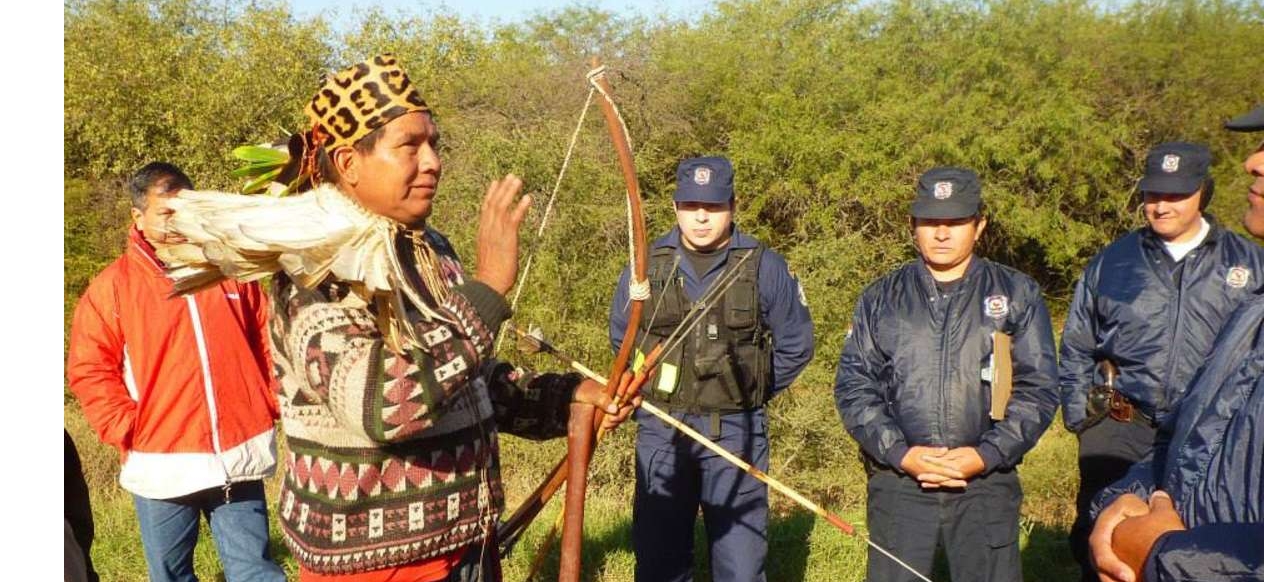
by DGR News Service | Oct 10, 2021 | Colonialism & Conquest, Indigenous Autonomy, Listening to the Land, Movement Building & Support, Repression at Home
This article originally appeared in Survival International.
Featured image: The Ayoreo have previously blocked the trans-Chaco Highway to draw attention to government inaction over the destruction of their forest. © GAT/ Survival
The survival of the last uncontacted tribe in South America outside the Amazon is at stake.
Indigenous people living in a South American forest with one of the world’s highest rates of deforestation have appealed to the Inter-American Commission on Human Rights to save it from total destruction. Their uncontacted relatives are fleeing from one corner of the remaining forest to another, seeking refuge from ever-present bulldozers.
The Ayoreo-Totobiegosode of Paraguay’s Chaco forest have been trying since 1993 – when they submitted a formal land claim – to protect their forest in the face of a rapidly expanding agricultural frontier.
In 2013, given a total lack of political will in Paraguay to uphold the law and stop the destruction of their lands, they requested that the Inter-American Commission on Human Rights intervene.
In 2016, at the government’s request, they agreed to enter formal negotiations with the government for their land titles, but for 5 years, and despite 42 meetings, the destruction of their forest has continued unabated. Satellite photos reveal that the Ayoreo now live in an island of forest surrounded by monocultures and beef production.
The Ayoreo have now announced they are pulling out of the negotiations, and have written again to the Inter-American Commission, asking it to order the Paraguayan authorities to finally return their land to them, and expel the agribusiness corporations that have taken it over.
Although most Ayoreo-Totobiegosode were forcibly contacted by American evangelical missionaries some years ago, an unknown number remain uncontacted in the last island of their forest, which is now being cut down around them.
Earlier this year one uncontacted group made contact with a settled community of their relatives, to express their fear at the destruction of their forest refuge, before returning to the forest.
The Ayoreo-Totobiegosode leader Porai Picanerai, who was forcibly contacted by the American New Tribes Mission in 1986, said: “My uncontacted relatives are suffering and in danger because they barely have any space now to live in. There are many outsiders occupying our land and burning the forest for beef production.”
Porai also said: “After having participated in most of the 42 meetings, I can confirm that the government doesn’t keep its word, that it lies and doesn’t want to protect my people or return the lands that we’ve always lived in and cared for. We’ll only get the government to act by going to outside bodies like the Commission.”
Survival Researcher Teresa Mayo said today: “The Ayoreo-Totobiegosode have called a halt to the negotiation process as the government was just dragging it out while allowing the rampant destruction of the Ayoreo’s forest to continue. The state knows that it simply has to do nothing to effectively condemn the uncontacted Ayoreo to death – and if a government sees the solution to its “problem” as the extermination of a people, we’re talking about genocide.”
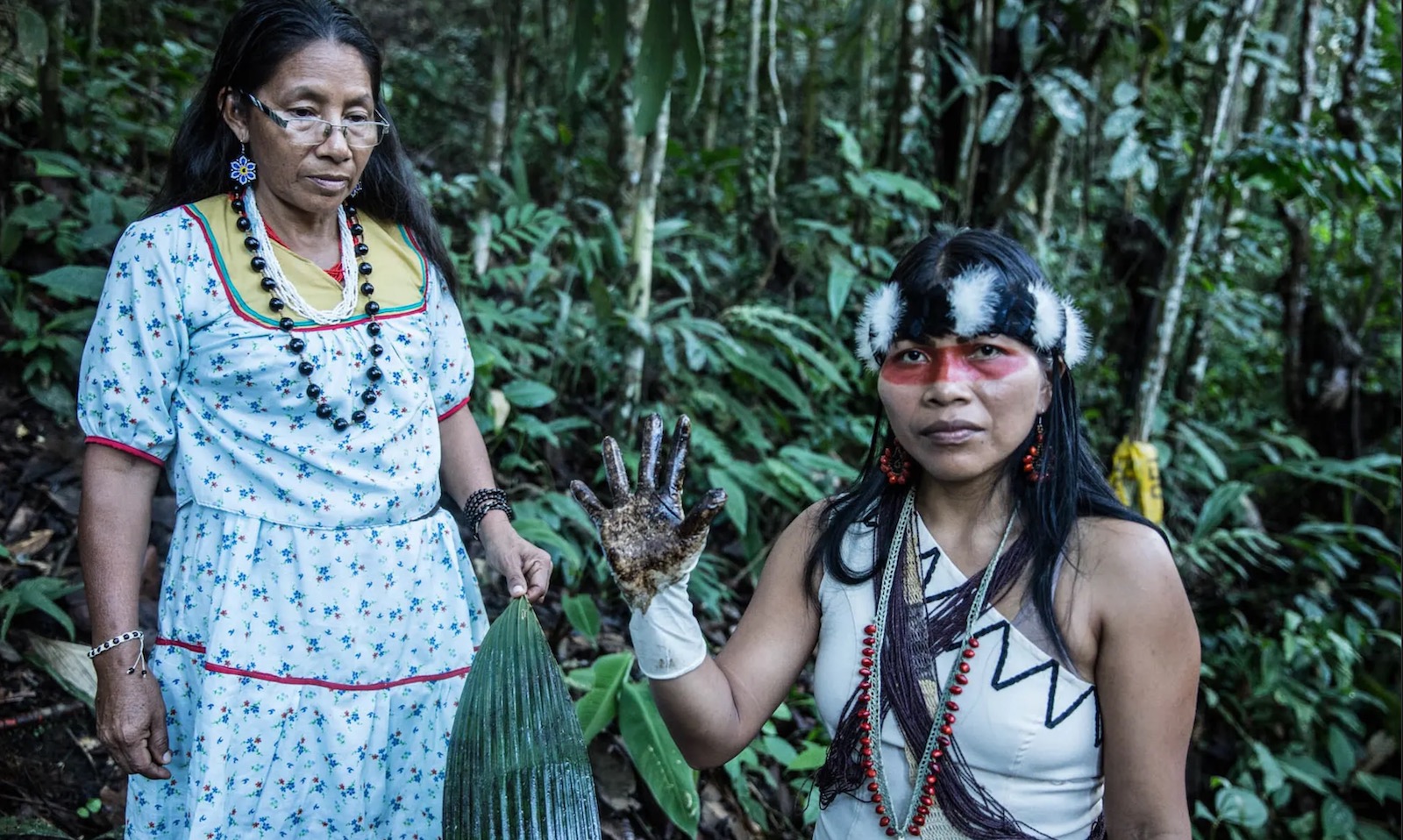
by DGR News Service | Oct 18, 2020 | ANALYSIS, The Problem: Civilization
We Indigenous people are fighting to save the Amazon, but the whole planet is in trouble because you do not respect it
by Nemonte Nenquimo / Originally published in The Guardian, Oct. 12 2020
Featured image: Waorani leader Nemonte Nenquimo shows evidence of crude oil contamination in the northern Ecuadorian Amazon rainforest. Photograph: Mitch Anderson / Amazon Frontlines
Dear presidents of the nine Amazonian countries and to all world leaders that share responsibility for the plundering of our rainforest,
My name is Nemonte Nenquimo. I am a Waorani woman, a mother, and a leader of my people. The Amazon rainforest is my home. I am writing you this letter because the fires are raging still. Because the corporations are spilling oil in our rivers. Because the miners are stealing gold (as they have been for 500 years), and leaving behind open pits and toxins. Because the land grabbers are cutting down primary forest so that the cattle can graze, plantations can be grown and the white man can eat. Because our elders are dying from coronavirus, while you are planning your next moves to cut up our lands to stimulate an economy that has never benefited us. Because, as Indigenous peoples, we are fighting to protect what we love – our way of life, our rivers, the animals, our forests, life on Earth – and it’s time that you listened to us.
In each of our many hundreds of different languages across the Amazon, we have a word for you – the outsider, the stranger. In my language, WaoTededo, that word is “cowori”. And it doesn’t need to be a bad word. But you have made it so. For us, the word has come to mean (and in a terrible way, your society has come to represent): the white man that knows too little for the power that he wields, and the damage that he causes.
You are probably not used to an Indigenous woman calling you ignorant and, less so, on a platform such as this. But for Indigenous peoples it is clear: the less you know about something, the less value it has to you, and the easier it is to destroy. And by easy, I mean: guiltlessly, remorselessly, foolishly, even righteously. And this is exactly what you are doing to us as Indigenous peoples, to our rainforest territories, and ultimately to our planet’s climate.
It took us thousands of years to get to know the Amazon rainforest. To understand her ways, her secrets, to learn how to survive and thrive with her. And for my people, the Waorani, we have only known you for 70 years (we were “contacted” in the 1950s by American evangelical missionaries), but we are fast learners, and you are not as complex as the rainforest.
When you say that the oil companies have marvellous new technologies that can sip the oil from beneath our lands like hummingbirds sip nectar from a flower, we know that you are lying because we live downriver from the spills. When you say that the Amazon is not burning, we do not need satellite images to prove you wrong; we are choking on the smoke of the fruit orchards that our ancestors planted centuries ago.
When you say that you are urgently looking for climate solutions, yet continue to build a world economy based on extraction and pollution, we know you are lying because we are the closest to the land, and the first to hear her cries.
I never had the chance to go to university, and become a doctor, or a lawyer, a politician, or a scientist. My elders are my teachers. The forest is my teacher. And I have learned enough (and I speak shoulder to shoulder with my Indigenous brothers and sisters across the world) to know that you have lost your way, and that you are in trouble (though you don’t fully understand it yet) and that your trouble is a threat to every form of life on Earth.
You forced your civilisation upon us and now look where we are: global pandemic, climate crisis, species extinction and, driving it all, widespread spiritual poverty. In all these years of taking, taking, taking from our lands, you have not had the courage, or the curiosity, or the respect to get to know us. To understand how we see, and think, and feel, and what we know about life on this Earth.
I won’t be able to teach you in this letter, either. But what I can say is that it has to do with thousands and thousands of years of love for this forest, for this place. Love in the deepest sense, as reverence. This forest has taught us how to walk lightly, and because we have listened, learned and defended her, she has given us everything: water, clean air, nourishment, shelter, medicines, happiness, meaning. And you are taking all this away, not just from us, but from everyone on the planet, and from future generations.
It is the early morning in the Amazon, just before first light: a time that is meant for us to share our dreams, our most potent thoughts. And so I say to all of you: the Earth does not expect you to save her, she expects you to respect her. And we, as Indigenous peoples, expect the same.
Nemonte Nenquimo is cofounder of the Indigenous-led nonprofit organisation Ceibo Alliance, the first female president of the Waorani organisation of Pastaza province and one of Time’s 100 most influential people in the world.

by DGR News Service | Aug 28, 2020 | Biodiversity & Habitat Destruction, Climate Change
Godwin Vasanth Bosco reports on extreme precipitation that has fallen on the Nilgiri plateau of southern India the last few years. These extreme and unprecedented rain events have led to massive landslides and other ecological damage. Little has been done to address the crisis.
Featured image: A massive landslide in one of the largest sholas in the Avalanche region of the Nilgiris, with hundreds of native trees and the stream ecology washed away.
Crumbling Ancient Mountain Ecology
Written and photographed by Godwin Vasanth Bosco / Down to Earth
Thousands of trees lay dead and strewn around the western parts of the Nilgiri Plateau in southern India.
Deep gashes scar ancient mountains slopes, standing a stark contrast to the lush green vegetation that they otherwise support. As conservationists, activists, and concerned people in various parts of India are fighting to protect forests and wilderness areas from being deforested, mined, and diverted to `developmental’ projects, there is another level of destruction that is happening to our last remaining wild spaces. Climate change is causing the widespread collapse of ecosystems.
Carbon dioxide levels in the atmosphere have just hit record-breaking levels of 417 ppm in May 2020. It has never been so high in the last 3 million years. Along with global warming caused sea-level rise and the melting of polar ice caps and glaciers, the steep increase in greenhouse gas concentrations has led to a surge in the frequency of extreme climate events. A region of the earth where climate change caused weather extremities are exceedingly apparent are the coastal plains and the Western Ghats regions of southern India. In the last four years, this region has been affected by eight tropical cyclones and consecutive extreme rainfall events during the southwest monsoon periods of the last two years.
These bouts of intense storms have been interspersed with periods of severe droughts, heatwaves, deficient, and failed monsoons.
On August 8, 2019, the Avalanche and Emerald valley regions, which are part of the Kundha watershed, received an unprecedented amount of over 900 mm [2.9 feet] of rainfall in 24 hours.
It broke the record for the highest rainfall ever recorded in Tamil Nadu, by nearly twice the amount. Over four days, this region experienced close to 2500 mm [8.2 feet] of rainfall. To put this in perspective, the nearest city (100 km east) in the plains of Tamil Nadu, Coimbatore, receives around 600 mm of rain annually. The Kundha watershed bore a deluge that was four times the annual rainfall amount, over just four days.
The upper watershed of the Kundha River is a complex of several peaks above 2400 meters and broad deep valleys. The Kundha River, which is a primary tributary to the Bhavani that feeds into the Cauvery, is fed by numerous streams and rivulets at the headwater sections.
With the barraging downpour, nearly every stream and rivulet burst its course. Vast tracts of precious soil and shola ecology slipped away on either side of the watercourses. Gone are the rich black soil layers topped with spongy humus that line the streams; washed away are dark moss and wild balsam covered rocks that shaped the flow of every stream; lost are the thousands of shola trees, dwarf bamboo and forest kurinji that guarded the streams, saplings, ferns and orchids of the forest floor. In place of these are deep cuts of gauged out the earth, revealing the red underlying lateritic soil layers, and lightly shaded freshly exposed rocks.

Numerous large landslides have occurred on intact grassland slopes too.

Uprooted and washed away trees, and dead Rhododendron arboreum ssp nilagiricum trees in a broad valley near the Avalanche region.

Native shola trees and stream ecology completely washed away on either side of tributaries of the Kundha River
Shola-grassland mosaic in danger
The cloud forest ecology, known as sholas, is specialized in growing along the folds and valleys of these mountains. They are old-growth vegetation and harbour several endemic and rare species of flora and fauna. These naturally confined forests are already some of the most endangered forest types, because of habitat loss and destruction.
The recent episode of extreme precipitation caused landslides, have dealt a telling blow on these last remaining forest tracts. What is even more shocking is that montane grassland stretches have also experienced large landslides.
The montane grasslands occur over larger portions of the mountains here, covering all the other areas that sholas do not grow in. Together, the shola-grassland mosaic is the most adept at absorbing high rainfall amounts and releasing it slowly throughout the year, giving rise to perennial streams. Over a year they can experience an upwards of 2500 to 5500 mm of rainfall, which is intricately sequestered by complex hydrological anatomy that carefully lets down most of this water, using what is needed to support the ecology upstream.
The native tussock grasses especially are highly adapted to hold the soil strongly together on steep slopes. However, even this ecology is now giving way under pressure from extreme weather events. The shola-grassland mosaic ecology cannot withstand the tremendously high amounts of rainfall (over 2400 mm) that occur in significantly short periods (over 4 days). Worsening climate change is driving the intensity and frequency of extreme weather events, resulting in a level of ecosystem collapse, never witnessed before.

An example of intact shola-grassland mosaic in the hills of the Nilgiri plateau, with the sholas growing in valleys and grasslands covering the slopes.
In the southwest monsoon season of 2018, similar events of unusually high rainfall occurred over the highland districts of Idukki, Wayanad, and Coorg, causing hundreds of landslides. A predominant view was that this was primarily because of the indiscriminate construction of roads and proliferating concretization of the hills.
However, even within the highly stable shola-grassland ecology, a large number of landslides have occurred in spots with no apparent forms of disturbance such as roads and pathways cut through them. This signifies that climate-change has reached a level that is beyond the capacity of the ecosystem and land resilience.
What is causing the collapse of the last remaining wild spaces is the culmination of every action that has contributed to the climate crisis.
These actions invariably stem from places that have long lost their plant ecological cover—urban-industrial-agricultural complex. There is fatally no time to keep ignoring this primary cause. Even if we ignore this and look to safeguard the last remain wilderness areas from being deforested or `developed’, they are vulnerable to climate change-related destruction.
Threats closer to the last remaining ecological spaces must be also curtailed. For instance, despite the consecutive years of extreme precipitation over short periods, in the Nilgiri Biosphere region, there are hardly any steps being taken to address ecological security. Building regulations stand to get eased and road expansion works continue in full swing.
However, worryingly similar to what happened in the last two years when much of the annual rainfall was concentrated over a few days later in the monsoon period, this year too, 2020 has be no different. The onset of the monsoon was delayed, and large parts of peninsula experienced a significant deficiency well into the monsoon period. This year’s monsoon has brought intense, short bursts of extreme rainfall, not only in the Western Ghats regions and southern India, but all across the Indian subcontinent.
Destruction by dams and tunnels

Neela-Kurinji or Strobilanthes kunthiana flowering in the grassland habitats of the Nilgiris. This spectacle takes place only once in 12 years
The Kundha watershed region can be broadly divided into two sections – the higher slopes and the descending valleys. Hundreds of landslides occurred in both these sections, with shola-grassland ecology dominating in the higher slopes, and various types of land-uses such as tea cultivation, vegetable farming, villages and non-native tree plantations dominating the descending valleys. The descending valleys are also studded with several dams and hydroelectric structures.
The Kundha Hydro-Electric Power Scheme is one of the largest hydropower generating installations in Tamil Nadu-with 10 dams, several kilometers of underground tunnels, and a capacity of 585 MW. In addition to this, this system is now getting two more dams and a series of tunnels, to set up large pumped storage hydropower facilities. The claim is to generate 1500 MW, of electricity during peak demand hours, but while using almost 1800 MW in the process.
With the level of destruction that extreme precipitation events are bringing to the Kundha watershed, it is disastrous to add more large dams and tunnels. The intensity of floods has turned so strong that even the largest dam complexes in the world, face threats of being breached.

An Aerides ringens orchid growing on a shola tree.
Safeguarding the last remaining zones of ecology and biodiversity from threats of direct destruction is crucial. Concurrently, the larger world-wide urban-industrial-agricultural complex, from where the climate crisis stems from needs drastic change. The constant incursions into more and more ecological spaces in the form of new dams, roads, and buildings, are also connected to this complex.
Whether it is the landslides in the grasslands of the high elevation plateaus in southern India; the melting glaciers of the Himalayas in northern India; the dying coral and rising sea levels elsewhere in the planet; the global coronavirus (Covid-19) pandemic that has brought about unimaginable changes – we have to understand the interconnectedness of these dire effects and learn from nature.
Godwin Vasanth Bosco is an ecologist working to restore shola and grassland ecology in the Nilgiri Biosphere. He is the author of the book Voice of a Sentient Highland on the Nilgiri Biosphere.
This piece was first published on Down to Earth. All the photographs were taken by the author himself.
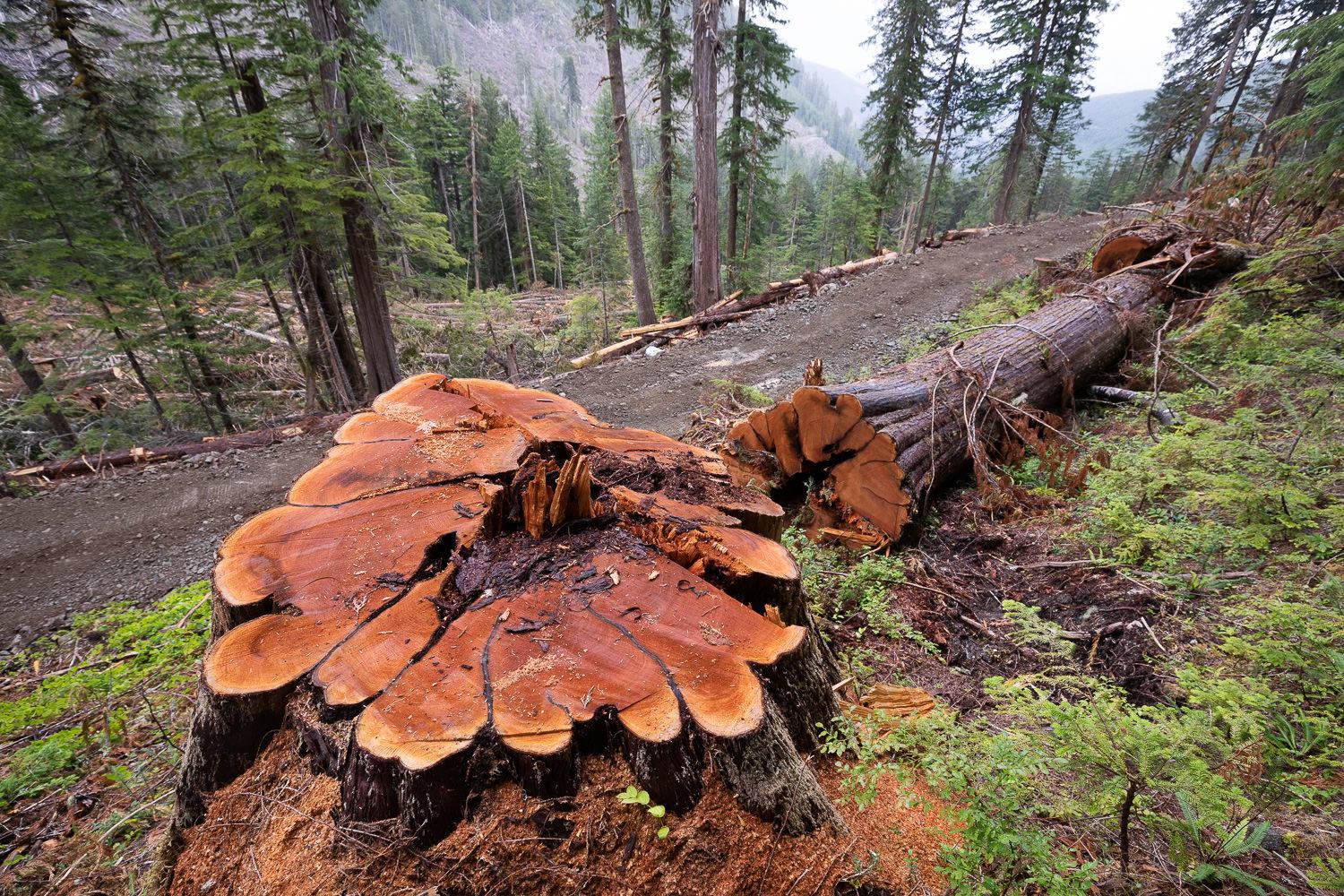
by DGR News Service | Aug 25, 2020 | Biodiversity & Habitat Destruction, Direct Action
A third blockade has started to stop the logging of near the headwaters of Fairy Creek. To learn more about the blockade in Fairy Creek, read the media release by the organizers of the blockade, and listen to interviews with Joshua Wright here and here. Access the official Facebook page here.
Two weeks into a campaign to halt logging of ancient rainforests in the last intact watershed of the San Juan River system, activists have set up a third blockade on unceded Pacheedaht territory!
Grassroots forest defenders from across Vancouver Island have successfully prevented Teal Jones Group from blasting logging roads into the unlogged headwaters of the Fairy Creek watershed for the past two weeks.
The first blockade was established on Monday, August 10th, where the new roads were about to crest a ridge into the west side of the watershed. The blockaders successfully turned away the road builders early that morning. Teal Jones removed their road building equipment on Tuesday, August 11th, and the blockade has remained in place continuously since then.
On August 17th, in light of government inaction to meet the blockaders demands, a second blockade was established just to the east of the Fairy Creek watershed, preventing Teal Jones from building roads which have been approved for construction into that side of the rainforest, located on unceded Pacheedaht Territory.
And on the evening of August 23rd, a third blockade was established. The third blockade is located on a logging road on Edinburgh mountain (also unceded Pacheedaht Territory). With the exception of Eden Grove on Edinburgh mountain, contiguous old-growth corridors have been severed between the rich valley bottom and the protected upper reaches. The infamous Big Lonely Doug stands in stark contrast to clear cut in a cutblock on Edinburgh, the sole remaining giant fir in the cut. Lonely Doug has become an internationally recognized symbol for BC’s devastating logging practices. Just up the mountain, logging is ongoing. This is what the newest blockade will stop.

Photo shows Teal Jones old-growth logging operations adjacent to Fairy Creek. Photo by Ancient Forest Alliance.
This new blockade also obstructs old growth logging already in progress east of Fairy Creek.
This stretch of ancient forest is contiguous with the intact old growth forest within the Fairy Creek watershed and contains high value valley bottom old growth forest that would be fully eradicated if the logging was allowed to continue. A massive, ancient cedar recently felled by Teal Jones in one of the old growth cut blocks now being blockaded:
“If anyone has ever felt called in their heart to take a stand for old growth forests, we invite them to join us here in Premier John Horgan’s own electoral riding: at our first blockade, or at this new, more easily accessible second blockade,” stated Cowichan Valley resident Caimen Shapiro.
Teal Jones, the licence holder of TFL 46, over the past month has begun road construction in the old growth hotspot of Fairy Creek that would enable them to clear-cut the upper Fairy Creek watershed, near Port Renfrew. The company has felled and graded several hectares of old growth forest on a road network that, had it not been for our first blockade, would have breached the ridgeline and entered the watershed.
Protection of Old Growth Forests
In view of the forthcoming release of theOld Growth Strategic Review (OGSR) report and recommendations, being held up by the BC government for up to 6 months from early May, with no firm release date to the public, we are again asking the Premier to establish:
1. The immediate and permanent protection of the entire Fairy Creek Valley, thereby nullifying all cut blocks and road construction approvals in the watershed and contiguous old growth forests. We demand this take place without a ‘land swap’ that would remove protections from other old growth forests to compensate Teal Jones.
2. An immediate end to old growth logging on Vancouver Island.
In an article in The Narwhal, Jan. 27, 2020, Gary Merkel, one of the two commissioners of the OGSR states: “I think the thing that surprised me the most is the degree of unanimity and common thinking around ‘we need to get back to the land’ and about moving past political cycles … we’re hearing it from almost everywhere,” Merkel told The Narwhal in a joint phone interview with Gorley: “We’re managing ecosystems — that are in some cases thousands of years old — on a four-year political cycle. The management systems change from government to government,” said Merkel, the former chair of both the Tahltan Nation Development Corporation and the Columbia Basin Trust.
We are now at the stage of final eradication of the ancient coastal temperate rainforest, reduced to less than 3% of its original extent by logging.
Port Renfrew has billed itself as the Big Tree Capital of Canada and this form of tourism has become the backbone of its economy. Once again, this future is threatened by the indiscriminate eradication of the ancient forests in this region. Here is a dramatic drone video of Fairy Creek watershed, recently captured by a young firefighter showing road-building crews cresting the ridge into the very last unlogged watershed in the San Juan River valley rainforest: https://www.youtube.com/watch?v=kBnhktwJIo4
If you are in a position to help you can find you way with this information: Blockade Directions: Blockade #1 (established August 10): GPS coordinates: 48°38’32.56″N 124°21’21.25″W
10 km on the Gordon River Main Line at Braden Creek Main Line (on your way to Fairy Lake after leaving Port Renfrew, turn left just past Deering Bridge and take the road up the hill to the right just before the bridge). Map: https://www.google.com/maps/place/48%C2%B038’37.3%22N+124%C2%B021’38.4% 22W/@48.6396915,- 124.357926,5720m/data=!3m1!1e3!4m5!3m4!1s0x0:0x0!8m2!3d48.6436944!4d- 124.3606667
Blockade #2 (established August 17) GPS coordinates: 48°38’12.66″N 124°17’29.97″W 6.7 km on the Granite Main Line from Pacific Marine Rd.
Map: https://www.google.com/maps/place/48%C2%B038’11.1%22N+124%C2%B017’25.0% 22W/@48.6053997,- 124.3902158,13000m/data=!3m1!1e3!4m5!3m4!1s0x0:0x0!8m2!3d48.63642!4d- 124.29028?hl=en
Media Contact: Joshua Wright, 360-989-8067 (jawrighter@gmail.com)
Featured image by Ancient Forest Allianc. Captured earlier this month from the Granite (Renfrew) Creek watershed, just over the ridge to the east of Fairy Creek in Pacheedaht territory. Teal-Jones was – until recently – also constructing roads and starting to clearcut old-growth forest in this area. The second blockade has now been set up by independent activists to prevent the company from continuing its destructive practices here as well.
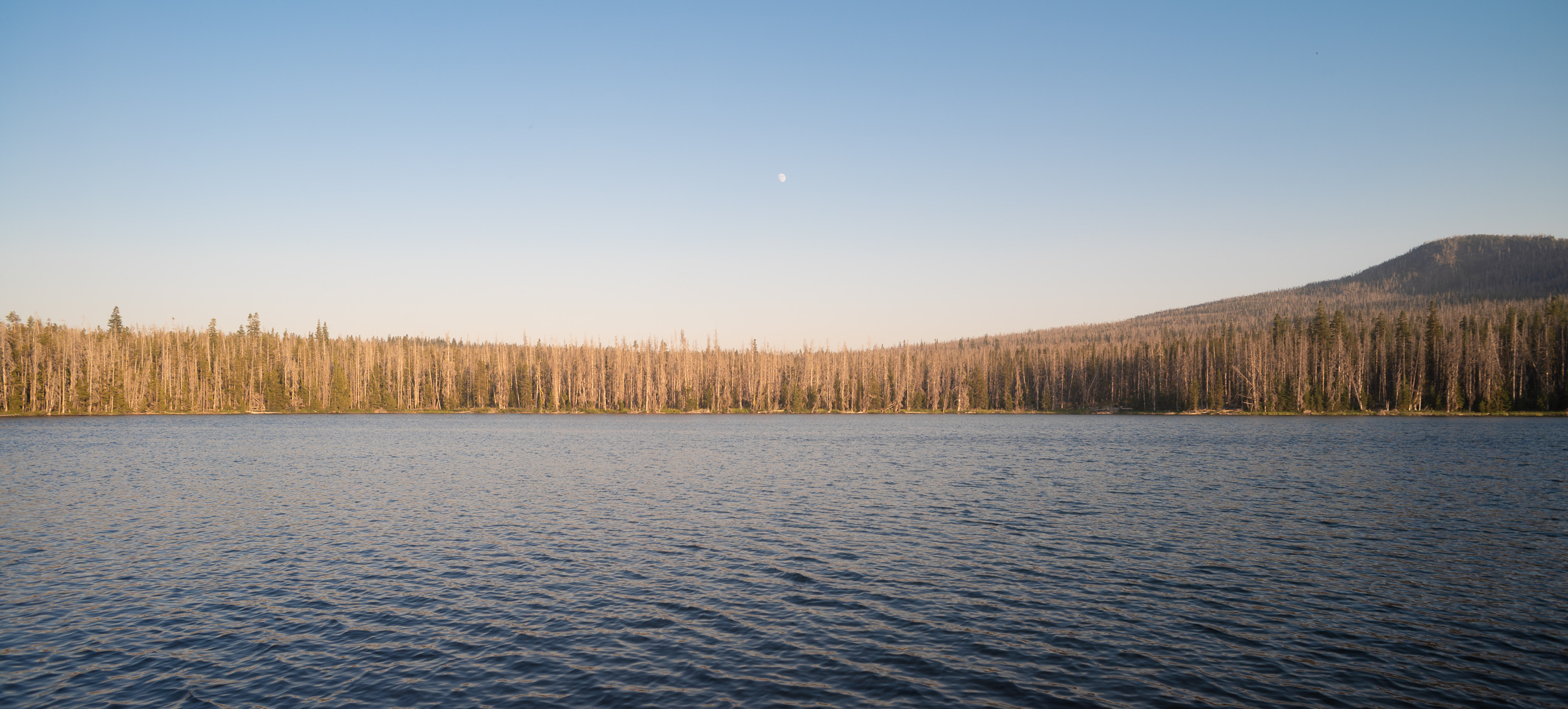
by DGR News Service | Aug 24, 2020 | Biodiversity & Habitat Destruction
Large and old-growth trees in the dry eastern region of the U.S. state of Oregon are under threat as the agency which regulates Forest Service lands plans to remove existing protections, George Wuerthner reports.
By George Wuerthner / The Wildlife News / August 13, 2020
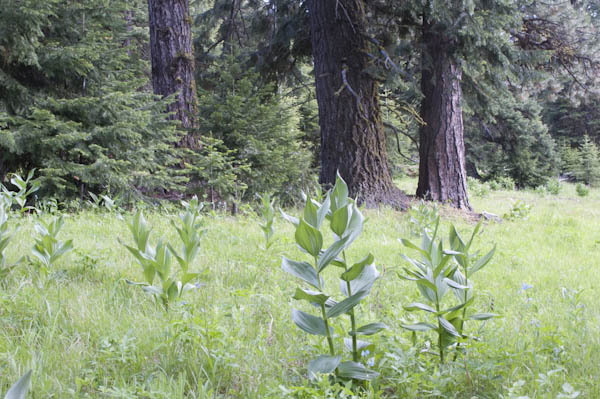
Old-growth grand fir on the Ochoco National Forest could be logged if the proposed removal of the 21-inch rule is adopted. Photo by George Wuerthner
The Forest Service has begun a 30 day comment period on its proposal to eliminate the 21-inch rule or what is known as the Eastside screens. The plan would remove a prohibition against cutting trees larger than 21 inches in the drier forests east of the Cascades in Oregon and Washington. The agency suggests that forests are denser than historical conditions and have shifted in their species composition. Not all researchers agree with this interpretation, but since these scientific studies don’t support more logging, they are usually ignored.
The agency researchers conclude that thinning forests is necessary to promote “forest health” and cutting of larger trees will hasten this transition. Since big trees enhance the profitability of timber sales, there is intense pressure from the timber industry for cutting big trees. However, the elimination of the 21- inch rule will increase the removal of large trees critical to healthy forest ecosystems.
The 21-inch rule was implemented in 1994 to protect larger trees from logging, partially in response to the realization that big trees have a disproportional ecological influence. Unlike the ancient forests west of the Cascades inhabited by the spotted owls, which gained some protection from the Endangered Species Act, eastside forests were vulnerable to the removal of old-growth forests.
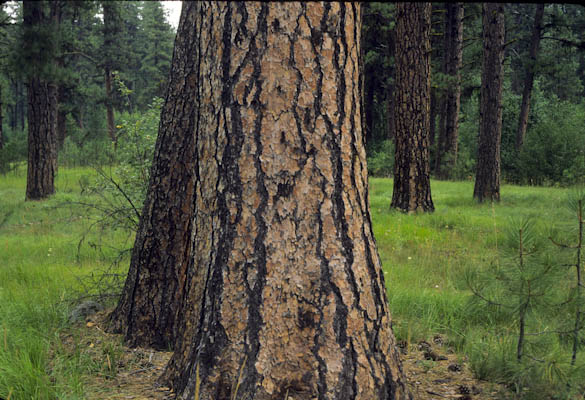
Large trees, even if dead, provide important ecological functions such as carbon storage and wildlife habitat. Photo by George Wuerthner
In response to the loss of large trees created by excessive logging, Congress convened a scientific panel to review the issue. However, unlike many such scientific panels that rely exclusively on forestry schools and/or the Forest Service for advice, Congress asked the Wildlife Society, the American Fisheries Society, the Society for Conservation Biology, and the American Ornithologists’ Union to produce the Eastside Forests Scientific Society Panel report. The panel came out with 13 suggestions, including a prohibition on cutting larger trees older than 150. The Forest Service adopted this policy recommendation.
But times have changed.
With the advent of the Trump Administration, there is intense pressure to increase the cut of timber. This pressure, along with collaborators who are more than willing to accommodate the timber industry’s and Forest Service demands (and rely exclusively on their science), many members of collaboratives including some so-called environmental groups support more logging.
In yet another example of the tail wagging the dog, the Forest Service now suggests that to “restore” eastside forests, and “save” them from (god forbid) death from wildfire or beetles, the agency must log the forest.
Part of the underlying assumption behind restoration is that forests are denser now than in the historical past due to fire suppression. The idea that you can restore the forest to some “historic” condition ignores the fact that all vegetation is a reflection of climate. The reason we see more mortality from fires, beetles, drought, and other ecological processes is primarily to changing climate. It’s warmer and drier. With less precipitation, higher temperatures, and more drought, you have the perfect ingredients for wildfire and bark beetle mortality.
There are many things wrong with this perspective.
Trying to emulate the historic forest condition created by the climate at that point in time, is not relevant to the forest structure today.
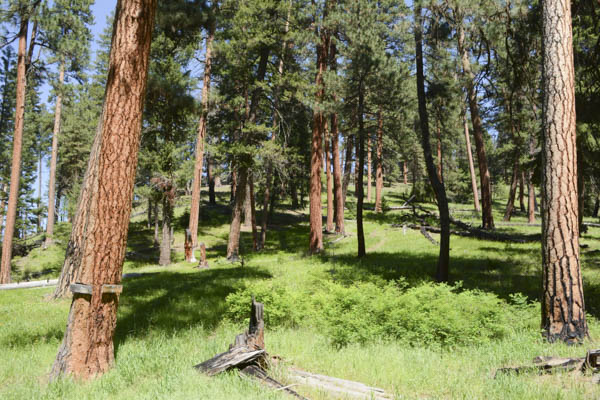
Part of the assumption behind removal of 21-inch screens is that eastside forests were characterized by open stands dominated by ponderosa pine as seen here. However, some researchers challenge the assumption that such forest structure was as common as presumed. Photo by George Wuerthner
Furthermore, natural evolutionary processes like bark beetles, drought, and fire are better, selecting which trees should and will survive than a logger with a chainsaw. For instance, it has been demonstrated that some trees have greater resilience to bark beetle predation, but this genetic advantage is not readily visible to foresters. By randomly logging/thinning the forest, logging may reduce the number of trees with genetic resistance to natural stresses, degrading the “resiliency” of the forest.
In a sense, the Forest Service and its collaborative allies see natural ecological processes like fire and beetles as the “enemy”. Somewhat like the attitude of some hunters view predators like wolves and cougars as “damaging” the deer and elk herds, many foresters and agency personnel view natural mortality from fires and beetles as counter to forestry goals of “green trees” and a source of fodder for sawmills.

Western larch, Glacier Mountain, Strawberry Mountains, Malheur National Forest, Oregon
This industrial forestry perspective is widely held in the timber industry, Forest Service, and its collaborative allies.
Yet dead trees are essential to healthy forest ecosystems.
They store carbon. They provide habitat as snags and down wood to many species from salamanders to animals as large as bears. For instance, grizzly bears rely on ants found in down trees for a significant proportion of their summer diet. And down trees in streams enhance the productivity of aquatic ecosystems. A substantial portion of birds and other wildlife utilize snags and dead trees at some point in their lifecycles. This is why some researchers have reported high biodiversity in the snag forests that result after a wildfire or bark beetle attacks.
Another rationale for eliminating the 21-inch rule is to reduce competition for resources and increase the remaining trees’ growth. Fast-growing trees are a goal of the Industrial Forestry Paradigm, but it is not necessarily good for healthy forest ecosystems. Slow-growing trees have denser wood, which makes the snags and down wood that remains after they die more resistant to rotting. Therefore, such dense wood is retained longer in the environment providing the above wildlife habitat and carbon storage benefits.
Although it is seldom admitted, one of the chief reasons for removing the 21-inch rule is to increase the economic viability of logging projects.
This is revealed in a recent review of the 21 inch rule in a paper recently published by the Forest Service. In that review, the authors suggest, ” Including larger trees in restoration prescriptions can increase the acreages where fuel treatments are financially feasible. Prestemon et al. (2012) showed that allowing the harvest of live trees over 21 inches increased the acreage in the West where fuel treatments were economically viable, even without considering avoided damage values”.
The paper goes on to note that: “Throughout the West, including live trees over 21 inches in fuel treatment harvests increased the viable treatment area by 2.6 times.” The review also notes: “It is important for managers and stakeholders to consider how large harvested trees can be processed locally to support local mills and be consistent with collaborative group goals.”
Here we see that meeting the goals of the collaboratives is more important than preserving healthy forest ecosystems.
The review admits that: “if no timber products could be sold from forest restoration actions, there was no place on the east side where the expected net economic benefit from fuel treatment would be positive, even when accounting for avoided wildfire damage.” As a consequence, we get to the heart of the issue. Without logging big trees, most thinning and other projects on eastside forests make no economic sense.
One way logging is further justified is by stewardship contracts. Stewardship contracts permit the Forest Service to take profits from timber sales and utilize for other forest projects like mitigating the ecological damage from previous logging projects by removal of culverts or closure of roads. I have often heard the so-called environmental representatives on collaboratives justify logging to me by saying, “ ?”
Of course, I support closing roads, but we don’t need to build more roads and log the forest to get some money to fix the damage from previous logging projects. Given the amount of money, the FS typically loses on timber sales. Putting agency funds towards road closure and other real restoration could be accomplished without having to log the forest to pay for these projects.
If you wish to send in your comments on the proposal to eliminate the 21-inch rule, individuals and entities are encouraged to submit comments via webform at https://cara.ecosystem-management.org/Public/CommentInput?project=58050.
Comments may also be sent via e-mail to: M.FS.EScreens21@usda.gov.
You can find the full & original article here: http://www.thewildlifenews.com/2020/08/13/eastside-forest-scam-the-removal-of-the-21-inch-rule/. Featured image by Max Wilbert.
















